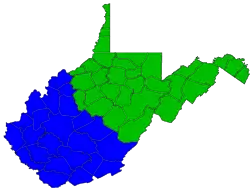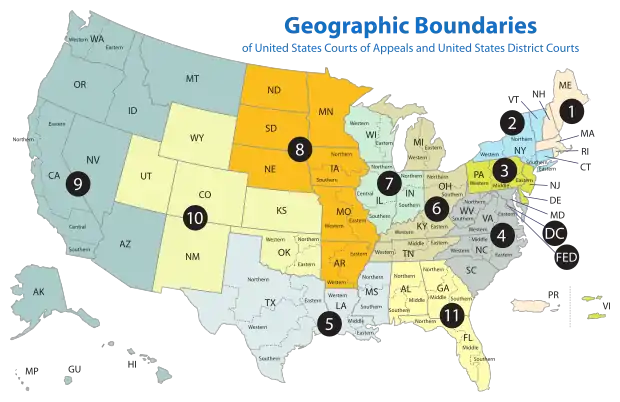United States District Court for the Southern District of West Virginia
The United States District Court for the Southern District of West Virginia (in case citations, S.D. W. Va.) is a federal court in the Fourth Circuit (except for patent claims and claims against the U.S. government under the Tucker Act, which are appealed to the Federal Circuit).
| United States District Court for the Southern District of West Virginia | |
|---|---|
| (S.D. W. Va.) | |
 | |
| Location | Charleston |
| Appeals to | Fourth Circuit |
| Established | January 22, 1901 |
| Judges | 5 |
| Chief Judge | Thomas E. Johnston |
| Officers of the court | |
| U.S. Attorney | Michael B. Stuart |
| U.S. Marshal | Michael Baylous |
| www | |
The District was established on June 22, 1901.[1]
The United States Attorney for the District is Michael B. Stuart.
Organization of the court

The United States District Court for the Southern District of West Virginia is one of two federal judicial districts in West Virginia.[2] Court for the Southern District is held at Beckley, Bluefield, Charleston, and Huntington.
Beckley Division comprises the following counties: Greenbrier, Raleigh, Summers, and Wyoming.
Bluefield Division comprises the following counties: Mercer, McDowell, and Monroe.
Charleston Division comprises the following counties: Boone, Clay, Fayette, Jackson, Kanawha, Lincoln, Logan, Mingo, Nicholas, Roane, Wirt, and Wood.
Huntington Division comprises the following counties: Cabell, Mason, Putnam, and Wayne.
Current judges
As of October 17, 2019:
| # | Title | Judge | Duty station | Born | Term of service | Appointed by | ||
|---|---|---|---|---|---|---|---|---|
| Active | Chief | Senior | ||||||
| 17 | Chief Judge | Thomas E. Johnston | Charleston | 1967 | 2006–present | 2017–present | — | G.W. Bush |
| 15 | District Judge | Joseph Robert Goodwin | Charleston | 1942 | 1995–present | 2007–2012 | — | Clinton |
| 16 | District Judge | Robert Charles Chambers | Huntington | 1952 | 1997–present | 2012–2017 | — | Clinton |
| 18 | District Judge | Irene C. Berger | Charleston | 1954 | 2009–present | — | — | Obama |
| 19 | District Judge | Frank W. Volk | Beckley | 1965 | 2019–present | — | — | Trump |
| 10 | Senior Judge | John Thomas Copenhaver Jr. | Charleston | 1925 | 1976–2018 | — | 2018–present | Ford |
| 14 | Senior Judge | David A. Faber | Bluefield | 1942 | 1991–2008 | 2002–2007 | 2008–present | G.H.W. Bush |
Former judges
| # | Judge | State | Born–died | Active service | Chief Judge | Senior status | Appointed by | Reason for termination |
|---|---|---|---|---|---|---|---|---|
| 1 | Benjamin Franklin Keller | WV | 1857–1921 | 1901–1921 | — | — | McKinley | death |
| 2 | George Warwick McClintic | WV | 1866–1942 | 1921–1941 | — | 1941–1942 | Harding | death |
| 3 | Harry Evans Watkins | WV | 1898–1963 | 1937–1963 | — | — | F. Roosevelt | death |
| 4 | Ben Moore | WV | 1891–1958 | 1941–1958 | 1948–1958 | — | F. Roosevelt | death |
| 5 | John A. Field Jr. | WV | 1910–1995 | 1959–1971 | 1959–1971 | — | Eisenhower | elevation to 4th Cir. |
| 6 | Sidney Lee Christie | WV | 1903–1974 | 1964–1974 | 1971–1973 | — | L. Johnson | death |
| 7 | Dennis Raymond Knapp | WV | 1912–1998 | 1970–1983 | 1973–1982 | 1983–1998 | Nixon | death |
| 8 | Kenneth Keller Hall | WV | 1918–1999 | 1971–1976 | — | — | Nixon | elevation to 4th Cir. |
| 9 | Charles Harold Haden II | WV | 1937–2004 | 1975–2004 | 1982–2002 | — | Ford | death |
| 11 | Robert Jackson Staker | WV | 1925–2008 | 1979–1994 | — | 1994–2005 | Carter | retirement |
| 12 | William Matthew Kidd | WV | 1918–1998 | 1979–1983 | — | — | Carter | seat abolished |
| 13 | Elizabeth Virginia Hallanan | WV | 1925–2004 | 1983–1996 | — | 1996–2004 | Reagan | death |
Chief judges
Chief judges have administrative responsibilities with respect to their district court. Unlike the Supreme Court, where one justice is specifically nominated to be chief, the office of chief judge rotates among the district court judges. To be chief, a judge must have been in active service on the court for at least one year, be under the age of 65, and have not previously served as chief judge. A vacancy is filled by the judge highest in seniority among the group of qualified judges. The chief judge serves for a term of seven years or until age 70, whichever occurs first. The age restrictions are waived if no members of the court would otherwise be qualified for the position.
When the office was created in 1948, the chief judge was the longest-serving judge who had not elected to retire on what has since 1958 been known as senior status or declined to serve as chief judge. After August 6, 1959, judges could not become or remain chief after turning 70 years old. The current rules have been in operation since October 1, 1982.
Succession of seats
|
|
|
|
| ||||||||||||||||||||||||||||||||||||||||||||||||||||||||||||||||||||||
|
|
|
| ||||||||||||||||||||||||||||||||
See also
References
- https://www.fjc.gov/history/courts/u.s.-district-courts-districts-west-virginia-legislative-history U.S. District Courts of West Virginia, Legislative history, Federal Judicial Center
- 28 U.S.C. § 129
